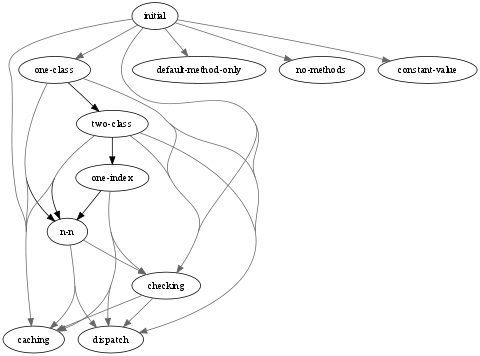
Figure 3.1
The system method on SB-MOP:COMPUTE-DISCRIMINATING-FUNCTION,
under most circumstances, returns a function which closes over a
structure of type SB-PCL::INITIAL, and which calls
SB-PCL::INITIAL-DFUN. This discriminating function is
responsible for implementing the computation of the applicable methods,
the effective method, and thence the result of the call to the generic
function. In addition, it implements optimization of these steps, based
on the arguments it has been called with since the discriminating
function was installed and the methods of the generic function.
For each substantive change of the generic function (such as addition or removal of a method, or other reinitialization) the discriminating function is reset to its initial state.
The initial discriminating function can transition into a discriminating
function optimized for the methods on the generic function
(SB-PCL::NO-METHODS, SB-PCL::DEFAULT-METHOD-ONLY,
SB-PCL::CONSTANT-VALUE), for slot access
(SB-PCL::ONE-CLASS, SB-PCL::TWO-CLASS,
SB-PCL::ONE-INDEX, SB-PCL::N-N1), or for dispatch based
on its arguments (SB-PCL::CACHING, SB-PCL::DISPATCH).
Those in the second category can transition into the third, or into a
SB-PCL::CHECKING state where the choice between
SB-PCL::CACHING and SB-PCL::DISPATCH has not yet been
made.
The possible transitions are shown in Figure 3.1.
[1] Would be better
named as M-N, as there is no requirement for the number of
classes and number of indices to be the same.